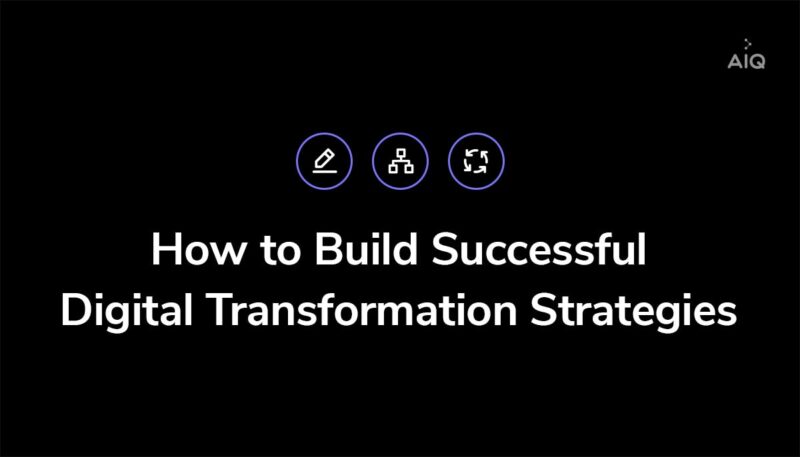How to Develop a Digital Transformation Strategy

In boardrooms and c-suites worldwide, executives and directors are looking ahead at one of the biggest challenges and risk factors that will confront businesses in the years to come: digital transformation. That concern isn’t unfounded: according to McKinsey, about 50% of all digital transformation initiatives never reach their intended value, and only about 10% outperform expectations.
But every established enterprise must find a way to clear the digital transformation hurdle. Facing a “constellation of risks” including aging legacy technology, digital description from more nimble and focused digital-native market entrants, and rapidly shifting customer preferences, companies will need to replace old business processes and adopt modern technologies in order to stay relevant and maintain a competitive advantage.
And even for those businesses whose top priority isn’t countering any of these threats, digital transformation will be a requirement for entering a new market, adopting a new business model, or expanding a company’s revenue streams.
In the insurance, wealth management, and banking sectors, for instance, “The companies that are utilizing digital technology and AI are ahead of the curve, the ones who aren’t, are struggling,” says Gary Bhattacharjee, head of the AI practice at Infosys.
What Is Digital Transformation?
At first glance, the magnitude of the digital transformation challenge seems overblown. After all, enterprises are good at deploying new technologies. They do it all the time. With dedicated IT teams, project management offices to ensure all goes smoothly, and sufficiently deep pockets to bring in top consulting expertise where skills aren’t readily available in-house.
But digital transformation simply isn’t what it seems at first glance.
First and foremost: digital transformation is not just about technology. Rather, digital transformation is a foundational change in how an organization delivers value to its customers. Technology is part of it, but people and processes are also critical. And it turns out that the people and process components are typically far more challenging than the pure technical aspects.
“Culture and technology go hand in hand,” says Jeff Wright, Global Head of Business Strategy & Operations at Dropbox.
What is a Digital Transformation Strategy?
At ActionIQ, we provide our customers with modern customer data platform (CDP) software. It’s digital technology that helps businesses put the customer at the center of everything they do.
In the early days of ActionIQ, we were working closely with a major brand to plan how they would use our technology to create better, more personalized experiences for their customers. The brand’s chief marketing officer was leading the evaluation. He was very interested—but at a certain point, he brought the evaluation to a halt. While he believed in the technology, he didn’t believe his organization was ready to adopt it successfully. His challenge was that his teams were accustomed to operating in silos.
Imagine, for instance, separate digital marketing teams for a retail brand’s stores vs. their ecommerce business. Each with their own digital & social media marketing, email marketing, and direct marketing sub-teams. That’s six teams along two separate lines of business, each possessing different skill sets, running a different business process, measured differently, and incented differently.
Now, try to bring in a technology designed to help you put the customer at the center of your business. Making their experiences seamless across every channel and touchpoint. Giving them one unified impression of your brand, whether they’re on the phone with the call center, in a store, or shopping on your mobile app. How can you do that successfully if your organization and processes are still running in those independently operated silos?
You can’t. That’s why the CMO in question went away for a while, kicking off a digital transformation strategy to align his people and processes around what ActionIQ’s technology had the potential to enable.
When he brought ActionIQ back in, the organization was ready to realign around new goals and prepared to get every ounce of value from the technology. More importantly, they were on a mission to truly change the way they delivered value to customers—through excellent customer experiences that would drive lasting loyalty.
Why You Need a Repeatable Digital Transformation Strategy
When a large enterprise declares it’s going to undergo a digital transformation, it’s a big thing. Such a decision is typically made at the CEO and Board of Directors level, and many layers of planning, action, technology, process, and organizational change result.
But the fact is, companies introduce new technologies all the time without a top-down initiative. And just about every new technology implies a change in process and the way people will work.
At ActionIQ, for instance, we work primarily with marketing departments. Believe it or not, due to the abundance of easy to implement SaaS and cloud software services, the average marketing organization has deployed an astounding 91 different martech tools.
Lured by the low-dollar entry point and “try it free” marketing of these solutions, organizations too often short-circuit the traditional tool selection and change management processes that should accompany the implementation of new solutions.
Yet these tools quickly become cemented within marketing workflows. On the technical side, the department soon becomes saddled with ill-considered systems architecture, system integration headaches, data silos, and data integration gridlock.
Costs for each system mount while marketers end up “swivel-chairing” between applications and manually manipulating data in spreadsheets. How can marketers put their focus towards improving the business when they are acting as band-aids between systems and processes?
It’s no wonder only 13% of marketers are confident they are getting the most out of their data with their current systems and processes. What are two of the top reasons they cite? Lack of skilled staff and training—two components essential to properly executing a digital transformation.
But at the root of the problem is a failure to recognize the introduction of any new user-facing technology as requiring some degree of digital transformation—requiring changes in process and skillsets in order to achieve success.
That’s why every company needs a digital transformation strategy framework that’s repeatable and applicable for both large scale and smaller-scale initiatives. One that can be applied where the genesis of the initiative is top-down, but also where new technology is brought into the organization at the grassroots.
A Framework for Developing Your Successful Digital Transformation Strategy
Digital transformation initiatives often begin with the solution—or the “how.” But at the beginning of a well-planned digital transformation journey, the “why” is more important than the “how.” Before arriving at a solution, you need alignment around the goals your digital transformation will achieve. After you’ve done so, you can then move on to defining the solution.
Define the “Why” of Your Digital Transformation
Here’s a framework we’ve used with clients to help them define the “why” of their digital transformation:
- Business case. Whether it starts out grassroots or top-town, every digital transformation needs executive sponsorship and organizational support. Your business case is the tool to win it. By building and socializing a strong business case with convincing ROI, you’ll get executives on board. You’ll also illustrate the business value that will convince colleagues it’s worth breaking out of their comfort zones to support organizational change. With organization-wide buy-in, your transformation is off to a strong start.
- Vision. The business case is a financial justification for your digital transformation. But the vision you set serves as the motivation. At the end of your transformation, how will you have changed the way you generate value for customers? How will your area of the business—or your whole brand—now be perceived? What will it now look like and feel like to be a customer or an employee? Once defined, the vision will become the ultimate destination for your people, processes, and technology roadmap.
- Roadmap. Realizing the vision requires a long-term roadmap. But you need short-term wins and tangible progress to keep up the momentum. According to McKinsey, the most successful digital transformations sprint out of the gates, delivering initial value quickly. You should build a plan that delivers about a quarter of your planned ROI within the first 3 months of your initiative, and anywhere from half to 75% of it within the first year. If your roadmap isn’t built this way, you may need to break your bigger plan into smaller phases, or apply an approach that’s a little more agile and a little less “waterfall.” When ActionIQ works with our customers on CDP deployments, we start out by designing a sequence of bite-sized goals and then line them up as milestones along the road to the ultimate vision.
- Definition of successful transformation success. The way in which you’ll determine success needs to be set upfront. This includes the specific metrics, how they’ll be measured, and how they’ll be made transparent across every stakeholder in the organization. You should have a single North Star KPI that the entire organization rallies around, as well as operational metrics (which may vary by department) that are linked to achieving the ultimate goal. In the work that ActionIQ does, KPIs like retention rate, NPS score, and revenue per customer often serve as the North Star. Then, operational metrics like email engagement, frequency of visits to the store, or time on site help departments and individuals in the company measure how their work contributes to the overarching goals.
Map Out the Jobs to Be Done
Your digital innovation will change the way work gets done in your organization. As we said earlier in the piece, companies often identify the lack of skilled personnel as a big reason they don’t get value from their technology investments. So, dealing with the skills gap is critical.
However, when organizations realize this, they often rush to write up new job specifications and launch a recruiting effort to fill them. But they often do so without planning for the new efficiencies that will be brought about by their transformation—so they end up overhiring and mis-hiring.
Instead of focusing on job titles, first, focus on jobs to be done. This is the critical work required to enact your transformation and then maintain and grow it after it’s complete. Being by categorizing the main functional areas of work. For many of the digital transformations ActionIQ participates in; for instance, the categories are 1) data access 2) strategy & insights 3) planning & operations, and 4) data science.
Next, for each area of work, list out the core tasks. Map those tasks to skills, and then determine when and for how long you’ll need them as part of the digital transformation journey. Based on the timeline and scale of need for each skill set, you can plan to contract, hire, or use tech vendors to fill the skills gaps.
With this approach, you will reduce expense over the course of your transformation, and operate with the agility, nimbleness, and efficiency that is the hallmark of a digitally transformed organization.
Evaluate the Maturity of Your Org
Now that you have your skills and people resources identified, you need to align people and teams within an org structure. It’s unlikely your current org design will be a good fit. But you don’t need to jump straight to a re-org, either. Like everything else in your digital transformation, take a phased approach that accrues measurable value and every degree of change.
Think of the marketing organization we used as an example earlier in this piece. It was organized around its channels, with business and technology professionals aligned to each channel. Before you go breaking this structure apart—but after all the stakeholders have bought into the digital transformation—think about the quick wins you can achieve from within these structures, like assembling a cross-functional tiger team to coordinate a customer-centric campaign that’s executed as a partnership across departments.
As your wins help build momentum for change, you’ll progress into increasingly more efficient and value-laden org structures. For instance, our hypothetical marketing organization would progress from its channel-centric structure to journey-centric and ultimately customer-centric org structures.
As you move along the organizational maturity curve, your teams will be positioned to extract the maximum value from your new technology. You’ll also have graduated to addressing the highest value use cases that deliver transformational customer and business impact.
Next Steps
We hope you find this framework useful for developing a successful digital transformation strategy for your organization. If you’d like to learn more about how a CDP can serve as the foundation of your company’s transformation into a customer-centric organization, here are two great ways to do it:
- Visit our resource library with lots of great additional content on change management and digital transformation
- Start a conversation with one of our experts by contacting ActionIQ today





